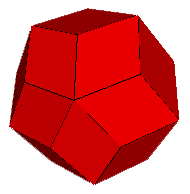
Dissecting the Rhombic Triacontahedron
The rhombic triacontahedron is the dual to the icosidodecahedron. It is formed from 30 identical rhombic faces. George Hart, on his page 'Dissection of the Rhombic Triacontahedron' discusses the dissection of the RTC into 20 Rhombic Hexahedra, of which 10 are 'acute' and 10 are 'obtuse' (my terminology: named after the vertices where three similar angles meet).
Below are two VRML models of this dissection, both show the growth of the rhombic triacontahedron from one rhombic hexahedron. During this process it was possible to pass through the rhombic dodecahedron (2nd kind) and the rhombic icosahedron. At these two points the model is recoloured to highlight these convex forms. The first model (left) shows only the rhombic hexahedra. The second model (right) shows this growth within the eventual framewowk forming the rhombic triacontahedron (the animated GIF above links to the same model).
In both models, the process is controlled by pressing the left mouse button in the lower centre of the screen. It starts off reading 'add 1st RH' (or 'add 2nd RH') and changes to denote the next action to be performed. See image below.

The following images show the growth from the initial frame up to the final rhombic triacontahedron. Clicking on the images leads to 'switch' files of the individual steps.
Stage 1. The initial rhombic hexahedron
Stage 2. Adding three further rhombic hexahedra produces the rhombic dodecahedron
Stage 3. Adding six further rhombic hexahedra produces the rhombic icosahedron
Stage 4. Adding the final ten rhombic hexahedra produces the rhombic triacontahedron
Convex Polyhedra containing Golden Rhombi
George Hart:
'Dissection of the Rhombic Triacontahedron'